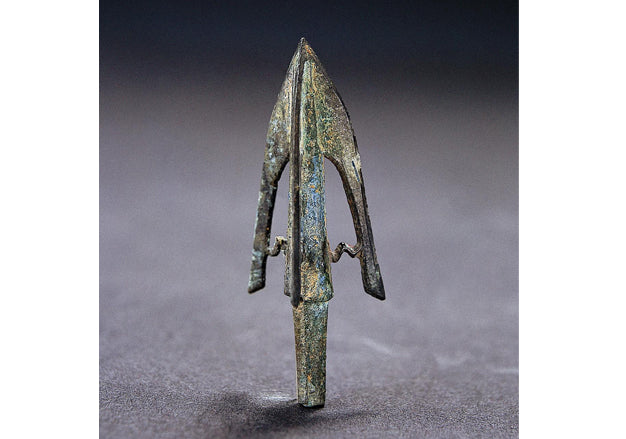
Three-winged arrowhead

The three-winged arrowhead is a bronze artifact from the middle of the Spring and Autumn Period. The remaining length is 5.1 cm. It was unearthed from the Liuli Pavilion Tomb A in Huixian County, Henan Province in 1936. It is now in the collection of the Henan Museum.
In August 1935, a local farmer found a bronze tripod while digging the ground north of the Liuli Pavilion in the southern suburbs of Huixian County. The county government reported it to the then Henan Provincial Government, and the provincial government ordered the Henan Museum (now the Henan Museum) to excavate it. The work started on September 4 and ended on November 5. After the first pit was excavated, the second pit of cultural relics was found three or four meters north of it. The second excavation began on October 26, and it was completed after 15 days. It was delivered to the Provincial Museum on November 16. The cultural relics in these two pits are two tombs. The excavators named them Tomb A and Tomb B. A total of more than 1,000 pieces of copper, jade, stone, and pottery were unearthed. The three-winged arrowhead was unearthed from the northeast corner of Tomb A.

Figure 1 Part of a three-winged arrowhead
This three-winged arrowhead from the Warring States Period has a sharp front and a triangular cross-section. It has a rear tip and three wings that are spread outward. The two-thirds of the wings are hollowed out, and the tail of the wings is connected to the joints with wavy thin supports. This design of a three-winged arrowhead makes the air resistance received by the arrow more uniform during flight, making the arrow more stable. The angle formed between the three wings has the same function as the blood groove on the blade of a double-winged arrowhead, making the three-winged arrowhead's characteristics of both lethality and penetration more obvious.
On the other hand, bronze arrowheads must be attached to the arrow shaft in order to be shot long distances. The base of the shaft where the string is held is called the "bracket". The "feather" is set on the bracket at one-fifth of the entire shaft. The feather is used to prevent the arrow from swinging during flight. When the arrowhead, shaft, and feather are combined, it forms a complete "arrow".


![8.3"China Shang Dynasty,Bronze wine cup [Fuhao Jue cup][妇好爵杯]](http://bronzc.com/cdn/shop/files/4ee0482982cfa89bb4d1cff3333a55e6_e3ca0b86-22fc-497d-9afd-578c551225a3-2.jpg?v=1733986652&width=533)

![12.8" China Ming Dynasty, Phoenix-patterned bronze vase[Ming Wanli Phoenix-patterned vase][明万历凤纹瓶]](http://bronzc.com/cdn/shop/files/4ee0482982cfa89bb4d1cff3333a55e6_a516991b-2bb9-4b2f-a2b6-4354129d006c.jpg?v=1733986953&width=533)

![14.6" China Eastern Han Dynasty Bronze vessel in the shape of a flying horse,Also known as bronze galloping horse[Horse Stepping on Flying Swallow][马踏飞燕]](http://bronzc.com/cdn/shop/files/4ee0482982cfa89bb4d1cff3333a55e6_aa3fbeb8-e08b-4a44-929a-13411ca8fb17-2.jpg?v=1733987211&width=533)

![5.9"China Tang Dynasty, Bronze of a walking dragon[Tang Walking Dragon][唐走龙]](http://bronzc.com/cdn/shop/files/2_8cb416b9-ebbd-4fe2-a905-b9277f820c16.png?v=1731488701&width=533)
